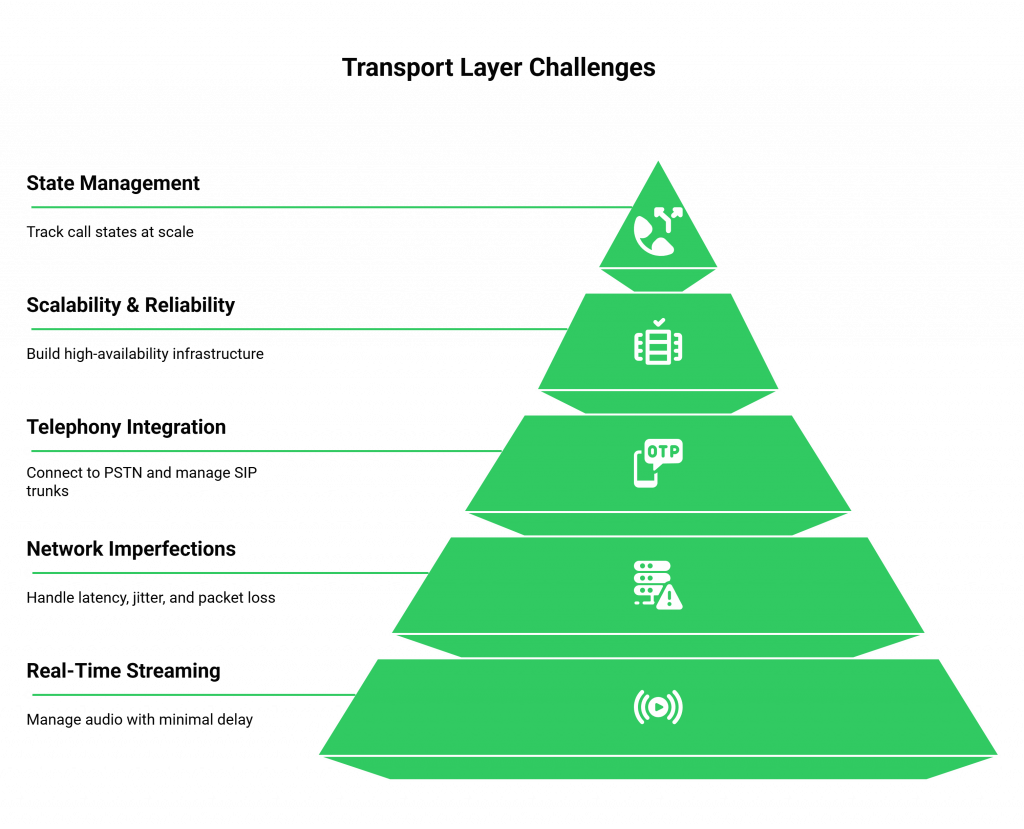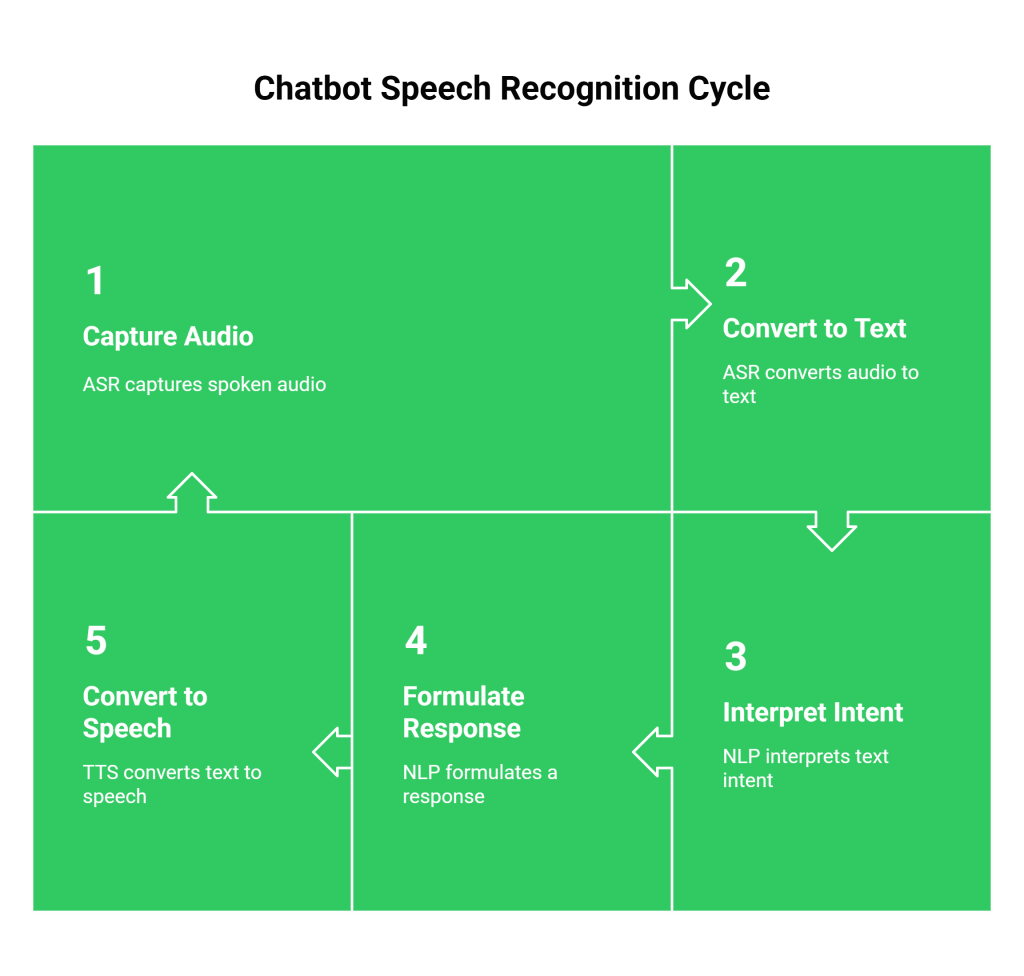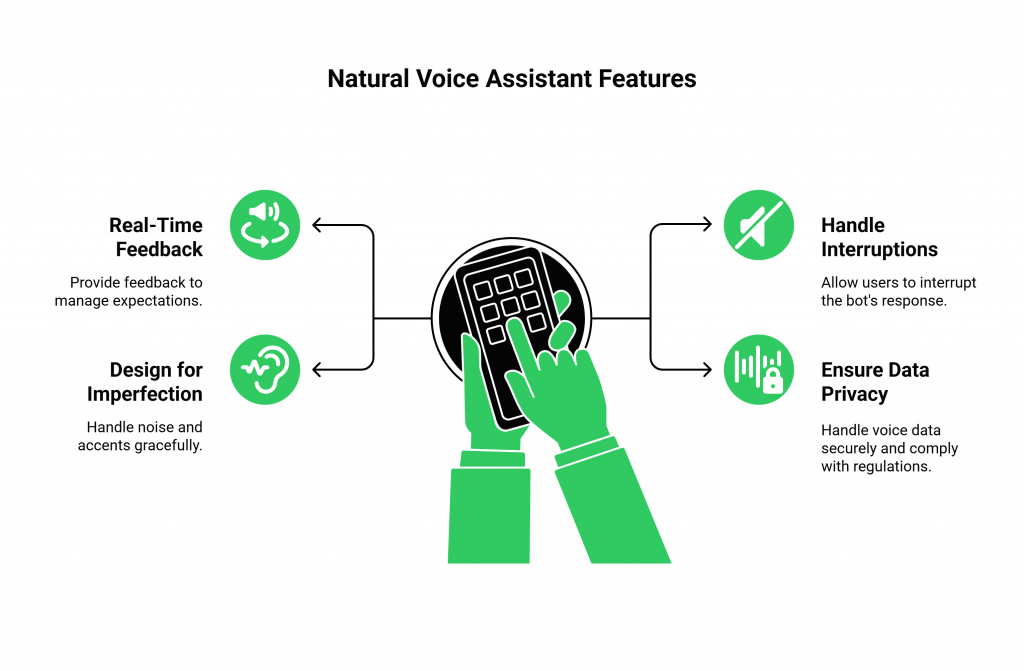Voice-based Conversational AI is transforming how businesses engage with customers, but building it takes more than just smart algorithms. FreJun bridges the gap between AI and real-time voice communication by providing the critical infrastructure needed for low-latency, high-quality voice interactions.
FreJun AI’s model-agnostic platform lets you bring your own AI while handling the complex telephony and audio streaming layers. From customer service automation to outbound sales, FreJun enables fast, scalable deployment of powerful voice agents without the burden of building from scratch.
Table of contents
- The AI Voice Revolution: More Than Just a Smart Script
- What is Voice-Based Conversational AI?
- The Hidden Hurdle: Why Voice AI Projects Stall on Infrastructure
- The Infrastructure Layer for High-Performance Voice AI
- Building on Bedrock: Core Features for Scalable Voice AI
- DIY Infrastructure vs. FreJun: A Strategic Comparison
- Blueprint for Launch: Deploying Your Voice Agent with FreJun in 3 Steps
- Unlocking Potential: Real-World Applications Powered by Robust Infrastructure
- Final Thoughts: Your AI is Only as Good as the Infrastructure It Runs On
- Frequently Asked Questions (FAQ)
The AI Voice Revolution: More Than Just a Smart Script
Businesses are racing to deploy voice agents capable of handling customer service inquiries, qualifying leads, and automating outbound campaigns. The global Conversational AI market is a testament to this, projected to skyrocket to $41 billion by 2030. The promise is transformative: 24/7 availability, infinite scalability, and personalized interactions that build loyalty.
In fact, over 60% of consumers now expect businesses to be available around the clock. Many organizations invest heavily in sophisticated Large Language Models (LLMs), believing a brilliant AI brain is the only component needed for success.
However, they soon encounter a frustrating and costly reality. An intelligent AI model is powerless if it can’t communicate clearly and instantly. The real challenge isn’t just programming the conversation; it’s building the underlying voice infrastructure to deliver it.
Awkward delays, garbled audio, and dropped calls can dismantle a user’s trust in seconds, turning a promising innovation into a brand-damaging liability. The gap between a text-based AI and a powerful voice agent is a complex bridge of real-time telephony, and most businesses are not equipped to build it.
What is Voice-Based Conversational AI?
Before addressing the infrastructure problem, it’s essential to understand the technology at its core. Conversational AI refers to a suite of technologies that allow machines to simulate human-like dialogue through voice or text. Unlike older, rule-based systems that followed rigid scripts, modern AI can understand context, interpret intent, and learn from interactions to provide fluid and relevant responses.
A functional voice-based AI system relies on several interconnected technologies working in perfect harmony:
- Speech-to-Text (STT): STT engine captures the user’s spoken words and converts them into machine-readable text.
- Natural Language Understanding (NLU): The “brain” of the operation, NLU processes the text to decipher the user’s intent, sentiment, and key entities.
- Dialogue Management: This component maintains the flow and context of the conversation, allowing for multi-turn interactions where the AI remembers previous statements.
- AI/LLM Logic: This is your core business logic or Large Language Model that processes the user’s intent and generates an appropriate text-based response.
- Text-to-Speech (TTS): This engine converts the AI’s text response back into natural-sounding spoken audio for the user to hear.
When these components work together seamlessly, they create a powerful tool for automation and engagement. The primary challenge is that the speed and clarity of this entire loop depend entirely on the quality of the voice transport layer connecting the user to these services.
The Hidden Hurdle: Why Voice AI Projects Stall on Infrastructure
Many development teams that excel at building AI models find themselves unprepared for the unique complexities of real-time voice communication. This infrastructure gap is where most voice AI initiatives either fail to launch or deliver a subpar user experience. The core challenges include:

- High Latency: Human conversation is intolerant of delays. Even a few hundred milliseconds of lag between a user speaking and the AI responding feels unnatural and breaks the conversational flow. Building and optimizing a global, low-latency media streaming stack is a monumental engineering task.
- Audio Quality and Clarity: The accuracy of your entire AI system begins with audio quality. If the initial voice input is corrupted by jitter, packet loss, or background noise, the Speech-to-Text engine will produce errors, leading your AI to misunderstand and provide irrelevant responses.
- Scalability and Reliability: A successful voice agent may need to handle thousands of concurrent calls. Engineering a system that can scale on demand while maintaining high availability and uptime requires geographically distributed infrastructure and significant capital investment.
- Complex Call Management: Beyond simple audio streaming, a production-grade system needs to manage complex call logic, handling inbound and outbound calls, routing, transfers, and maintaining a stable connection for long-running conversations.
- Integration Complexity: Stitching together telephony carriers, media servers, and your various AI services (STT, LLM, TTS) into a cohesive, low-latency pipeline is notoriously difficult and distracts your team from its primary goal: building great AI.
Attempting to build this voice plumbing from scratch diverts critical resources, extends development timelines, and rarely produces the quality needed for a positive customer experience.
The Infrastructure Layer for High-Performance Voice AI
FreJun AI handle the complex voice infrastructure so you can focus on building your AI. FreJun is not another LLM or AI provider. We are the enterprise-grade voice transport layer designed for speed and clarity, turning your text-based AI into a powerful, production-ready voice agent.
Our platform serves as the reliable, low-latency “plumbing” that connects your users to your AI services. We manage the real-time media streaming, call management, and robust telephony connections, allowing you to bring your own AI model (BYO-AI). With FreJun, you maintain full control over your AI logic and dialogue state while we ensure every word is transmitted with pristine clarity and minimal delay.
By abstracting away the immense complexity of voice infrastructure, FreJun empowers you to launch sophisticated voice agents in days, not months. This aligns with modern business needs, as enterprises that optimize their build vs. buy process achieve up to 30% faster time-to-market.
Building on Bedrock: Core Features for Scalable Voice AI
FreJun provides a complete toolkit designed for building and deploying scalable voice applications. Our features are engineered to solve the core infrastructure challenges that hinder Conversational AI projects.

1. Engineered for Low-Latency Conversations
Natural conversation requires speed. The industry standard service level for call centers is to answer 80% of calls within 20 seconds, and high latency makes this target impossible to meet. Our entire stack, from the API to the underlying media servers, is optimized to minimize latency and eliminate the awkward pauses that destroy user experience.
2. Direct LLM & AI Integration
Our API is model-agnostic. You bring your own AI. Whether you are using a model from OpenAI, Google, Anthropic, or a proprietary in-house solution, FreJun AI acts as the seamless voice interface. This approach gives you complete freedom and control over the “brains” of your operation, while we expertly manage the voice layer.
3. Enable Full Conversational Context
For an AI to have a meaningful conversation, it must remember what was said. FreJun’s platform acts as a stable transport layer, maintaining the connection reliably so your backend application can track and manage the conversational context independently. This is vital for complex inquiries, as 75% of consumers still prefer human agents for complex issues, often due to an AI’s inability to handle nuanced dialogue. Our stable infrastructure provides the clear channel your AI needs to follow these multi-turn conversations.
4. Developer-First SDKs
We are built for developers. Our comprehensive client-side and server-side SDKs accelerate your development cycle dramatically. You can easily embed voice capabilities directly into your web or mobile applications and manage all call logic from your backend, streamlining the entire process from concept to production.
DIY Infrastructure vs. FreJun: A Strategic Comparison
For businesses venturing into voice AI, the choice is clear: build a complex voice stack from the ground up or leverage a dedicated platform. The table below outlines the strategic differences.
| Feature | Building DIY Voice Infrastructure | Using FreJun’s Voice AI Platform |
| Development Time | 6-12+ months or more. | Days to weeks |
| Upfront Cost | High (Avg. US developer salary is $95k/year, plus hardware and contracts). | Low (Predictable subscription fees). |
| Latency | Variable; difficult to optimize globally. | Ultra-low; optimized by design. |
| Scalability | Manual; requires significant engineering effort. | Automatic; built on geo-distributed infrastructure. |
| AI Model Control | Full Control (if built correctly). | Full Control (BYO-AI model). |
| Maintenance | High ongoing overhead, accounting for up to 65% of total software costs. | Zero; managed entirely by FreJun. |
| Core Focus | Divided between AI and complex voice plumbing. | 100% focused on building the AI application. |
| Security | Self-managed; potential for vulnerabilities. | Enterprise-grade security built-in. |
Choosing FreJun allows your team to bypass the immense cost, time, and risk associated with building voice infrastructure, enabling you to focus your resources on what truly differentiates your business: the intelligence of your AI.
Blueprint for Launch: Deploying Your Voice Agent with FreJun in 3 Steps
FreJun simplifies the path to production. Our architecture is designed to create a clean, efficient loop between the user and your AI. Here is the step-by-step process for bringing your voice agent to life.

Step 1: Stream Voice Input to Your Application
It all starts with capturing the user’s voice. FreJun’s API captures real-time, low-latency audio from any inbound or outbound call. This raw audio stream is forwarded directly to your application’s endpoint, where your chosen Speech-to-Text (STT) service transcribes it. Our infrastructure ensures every word is captured clearly and delivered without delay, providing a clean input for your AI.
Step 2: Process the Input with Your AI
Once the audio is transcribed, your application takes full control. FreJun serves as a reliable transport layer while your backend manages the dialogue state. You feed the user’s transcribed text into your AI logic or Large Language Model. Your AI processes the intent, consults any necessary data sources, and generates a text-based response. Because you control this entire step, you can connect to any context management solution or internal API you need.
Step 3: Generate and Stream the Voice Response
The loop is completed by giving the AI a voice. Your application takes the text response generated by your AI and pipes it into your chosen Text-to-Speech (TTS) service. The resulting audio is then streamed back to FreJun’s API, which plays it back to the user over the call with minimal latency. This seamless, three-step process creates a fluid and responsive Conversational AI experience.
Unlocking Potential: Real-World Applications Powered by Robust Infrastructure
When the infrastructure challenges are solved, the possibilities for voice-based Conversational AI become limitless. Businesses across industries can deploy sophisticated voice agents to handle a wide variety of tasks.
Intelligent Inbound Call Handling
Automate your front line with AI-powered agents. Businesses report operational cost reductions of up to 30% by implementing AI for customer service. These agents can function as 24/7 receptionists or Tier 1 support, understanding natural language, answering complex questions, and reducing the need for human intervention. This is crucial as 51% of consumers expect 24/7 availability.
Scalable and Personalized Outbound Campaigns
Execute outbound campaigns that feel personal and engaging. Automating lead qualification can result in an around 10% increase in revenue within nine months. AI voice agents can automate appointment reminders, conduct lead qualification calls, and gather feedback. Automating these processes is key, as studies show 67% of lost sales are due to sales teams failing to qualify leads properly.

FreJun provides the reliable foundation needed to build and scale these applications with confidence, ensuring your Conversational AI delivers on its promise.
Final Thoughts: Your AI is Only as Good as the Infrastructure It Runs On
The journey from a simple call to a meaningful conversation is paved with immense technical challenges. While the intelligence of your AI model is critical, its potential is fundamentally limited by the infrastructure that carries its voice. In the world of voice AI, latency is the enemy of trust, and clarity is the currency of understanding.
Attempting to build this foundational layer in-house is a strategic misstep that drains resources and delays innovation. Buying an off-the-shelf solution is almost always more cost-effective. The future of automated business communication belongs to those who understand where to focus their efforts.
FreJun Teler provides the definitive answer. By handling the complexity of real-time voice infrastructure, we empower you to channel your resources into what you do best: building groundbreaking AI. Our developer-first platform provides the speed, reliability, and security needed to deploy enterprise-grade Conversational AI that engages customers, automates processes, and drives business growth.
Click Here to Try FreJun Teler!
Also Read: The Benefits of Using AI Insight for Call Management
Frequently Asked Questions (FAQ)
No. FreJun is a model-agnostic voice infrastructure platform. We provide the real-time media streaming and call management APIs that allow you to connect your own AI model, chatbot, or Large Language Model (LLM) to the telephone network. You maintain 100% control over the AI logic.
FreJun does not provide STT or TTS services. Our platform is the transport layer that streams raw audio from the call to your application, where you can process it with your preferred STT provider.
Our entire platform is architected for low-latency performance. We utilize a globally distributed infrastructure and real-time media streaming protocols specifically optimized for voice.
We offer dedicated integration support to ensure a smooth journey from concept to launch. Our team of experts provides guidance during pre-integration planning to help you architect your solution correctly and offers post-integration support to help you optimize performance and scale your application.
Absolutely. Our API and infrastructure are designed to handle both inbound and outbound call scenarios. You can build solutions to lower your call abandonment rate which can be as high as 7% in sectors like healthcare or improve the efficiency of outbound campaigns.
Yes. Security is a core tenet of our platform. We employ robust security protocols at every layer to ensure the integrity and confidentiality of your data. Our platform is designed to meet the mission-critical security and reliability standards required for enterprise deployment.
